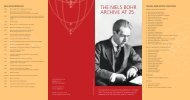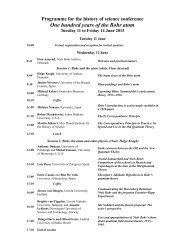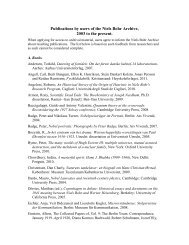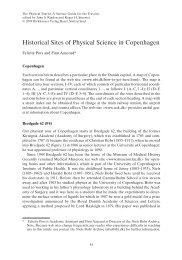Love and physics: Margrethe Nørlund and Niels Bohr's creativity ...
Love and physics: Margrethe Nørlund and Niels Bohr's creativity ...
Love and physics: Margrethe Nørlund and Niels Bohr's creativity ...
Create successful ePaper yourself
Turn your PDF publications into a flip-book with our unique Google optimized e-Paper software.
Megan Shields Formato, Harvard University, U.S.A.<br />
Writing the Atom: Writing Practices <strong>and</strong> the Bohr Atom<br />
This paper describes how an important moment in early twentieth century <strong>physics</strong> – the discovery <strong>and</strong><br />
description of the Bohr model of the atom– was contingent upon the strange writing practices of the<br />
Danish physicist <strong>Niels</strong> Bohr. In the primary <strong>and</strong> secondary literature Bohr’s writing practices have the<br />
status of an entertaining puzzle or peripheral anecdote, something that is always mentioned but almost<br />
never taken up directly. He skied slowly; he recited Icel<strong>and</strong>ic sagas; <strong>and</strong>, by the way, he moved through<br />
upwards of fifty drafts for a simple birthday card <strong>and</strong> dictated many of his first drafts to his wife,<br />
<strong>Margrethe</strong>. In my project, I move Bohr’s writing practices to the center <strong>and</strong> ask what these practices<br />
were, how they acted as tools in quantum theory, <strong>and</strong> how they can help us to access <strong>and</strong> describe the<br />
competing ideas about scientific communication held by the wider <strong>physics</strong> community between 1911<br />
<strong>and</strong> 1924. In this paper, I will look at how Bohr’s writing <strong>and</strong> dictation practices worked sometimes in<br />
t<strong>and</strong>em <strong>and</strong> sometimes against his choice to model the electron’s orbit on more familiar, but much<br />
larger planetary systems.<br />
This paper builds on other work by historians of science such as Andrew Warwick, David<br />
Kaiser <strong>and</strong> Ursula Klein who share the questions of how the material practices <strong>and</strong> technologies—the<br />
“paper tools”—leave traces in the theoretical conceptions themselves. I ask how Bohr’s dictation,<br />
writing <strong>and</strong> drawing practices persist in the models <strong>and</strong> theories he helped create.<br />
Karl Gr<strong>and</strong>in, Royal Academy of Science, Sweden<br />
<strong>Niels</strong> Bohr as seen from a Swedish perspective<br />
<strong>Niels</strong> Bohr made several crucial contributions to the development of <strong>physics</strong> in the 20 th century, not<br />
only through his scientific publications but also through establishing the important environment for<br />
international collaboration at the institute at Blegdamsvej. In this talk I will investigate Bohr’s activities<br />
from a Sc<strong>and</strong>inavian perspective, especially Bohr as seen from the Swedish perspective. Besides all his<br />
other important activities Bohr took an active interest throughout his career in the local promotion of<br />
the physical sciences. Bohr as seen from a Swedish perspective might then not only satisfy the local<br />
historical interest in the matter, but also add elements to the underst<strong>and</strong>ing of Bohr’s work by taking the<br />
Sc<strong>and</strong>inavian connection into consideration. There is a story from the Second Sc<strong>and</strong>inavian Congress<br />
of Mathematicians in Copenhagen in 1911, when the Swedish theoretical physicist C.W. Oseen came<br />
into contact with <strong>Niels</strong> Bohr <strong>and</strong> subsequently supported Bohr in obtaining a professorship <strong>and</strong><br />
discussing how to strengthen <strong>physics</strong> in Denmark <strong>and</strong> Sweden. Later on Bohr was even offered to<br />
become a member of the <strong>physics</strong> Nobel committee. The Sc<strong>and</strong>inavian element is even more<br />
pronounced after the war through for instance discussions of the peaceful uses of nuclear energy with<br />
the Swedish Prime Minister Tage Erl<strong>and</strong>er <strong>and</strong> the establishment of Nordita.<br />
5








